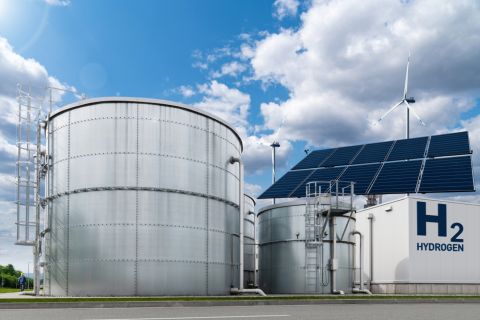Ask anyone in the industry what the United States needs to quench its infamous thirst for natural gas, and increased imports of liquefied natural gas likely will be on that list. Ralph Eads, president of El Paso Merchant Energy Group, says LNG will be among the fastest-growing segments of the energy industry. He expects a 10% to 15% annual growth rate during the next decade. Pretty high expectations for an energy source that currently satiates less than 2% of U.S. gas demand-and financially clobbered El Paso when it last bet on an LNG strategy, which was in the 1970s. But while El Paso is perhaps the most vocal backer of North American LNG today, it's certainly not the only one. Major companies such as Dynegy, Williams, Enron, Chevron, Texaco and BP, and even smaller players such as Cheniere Energy, are studying ways to expand the country's-and their own-ability to import LNG. "LNG's unique characteristics suit it perfectly to serve markets that will likely change significantly in the near future," says Peter Hughes, senior director, European energy, Cambridge Energy Research Associates. CERA believes the worldwide LNG industry could triple in size during the next 20 years. "Gas-reserve holders will be able to capitalize on LNG's marketing flexibility at the same time as the industry's cost structure has been significantly improved by recent technological developments." LNG is a decades-old way of transporting natural gas long distances without a pipeline. The gas is cooled to -256˚F which liquefies it and shrinks it to 0.06 its original volume. The LNG is then shipped by tanker to regasification terminals, where it is transformed back into a gas. In the 1970s, four such regasification terminals were built: in Everett, Massachusetts; Lake Charles, Louisiana; Elba Island, Georgia; and Cove Point, Maryland. But as natural gas shortages of the 1970s led to the gas bubble of the 1980s, LNG fell out of favor. That disenchantment lasted two decades. Today, only the Everett and Lake Charles terminals are fully operational. Combined, they send out about 2.4 billion cubic feet (Bcf) of gas a day. During the next 10 years, however, the U.S. LNG business promises to look vastly different. William Smith, president of El Paso Global LNG, says that by 2010, LNG supply could grow to between 6- and 10 Bcf per day. "I have even seen estimates that are larger than that," he says. The motivation What's behind the expected resurgence? Underpinning the optimism is, of course, the widely accepted belief that natural gas prices have settled into a new, higher range that will be sustainable for years. But experts say there's more to it than that. "The cost of liquefaction, shipping and regasification has come down very dramatically in recent years-to probably 25% to 30% less today than it was 10 years ago," Smith says. Generally, a regasification facility that can send out between 0.5- and 1 Bcf of gas per day costs $350- to $450 million to build. Liquefaction facilities in the exporting countries range from $1.2- to $1.6 billion, and the carrier ships cost about $170 million each, he says. While the whole business is far from cheap, Smith says construction of new North American receiving terminals is viable with gas prices of $3- to $3.50 per thousand cubic feet. "That is highly variable," he says. "You might even be able to think about a lower price with a much shorter shipping route." Another big plus, Smith says, is that there is a large number of new supply projects under development, and exporting countries might like to diversify their customer base beyond Europe and Asia. Overall, it has been estimated that there are 700 trillion cubic feet of proved natural gas reserves that are stranded worldwide. "We have observed that in the last 18 months to two years, there have been a number of significant finds of natural gas that we might characterize as relatively stranded," he says. "So there are more projects out there looking for a place to deliver. That is almost independent of what has happened with U.S. gas prices." Some of these new projects are relatively close to the U.S., a fact that has heightened industry interest in the Cove Point, Maryland, receiving terminal, which Williams plans to reopen, says Joe Fields, Williams director of project development for the terminal. Cove Point's previous owner, Columbia Energy Group, conducted an open season for firm LNG-tanker discharging service at the facility, and the interest was strong. "The open season for this facility was held last year, and these people signed up for this capacity before the big escalation in gas prices. So these companies thought that there was a market for LNG even before such a precipitous increase in the gas price," Fields says. "I think what's changed since these facilities were in service in the 1970s is you now have a major source of LNG close to the U.S. in Trinidad, and another potential source in Venezuela." The round trip from Trinidad to Cove Point takes about 12 days; from Australia it's about 64 days. Proximity is important because the tab to lease an LNG carrier is $50,000 to $100,000 a day, he says. Plus, LNG cargoes gradually shrink during their journeys, making a short travel time even more desirable. According to Atlantic LNG Co. of Trinidad and Tobago, the country has 23 trillion cubic feet of proven reserves, 12 trillion cubic feet in probable and possible reserves and 65 trillion cubic feet left to find. Reopening terminals Because of this LNG-friendly environment, the two U.S. terminals that are not receiving imports-Cove Point and Elba Island, Georgia-are scheduled to do so in the near future, and the terminal at Lake Charles, Louisiana, will be expanded. Williams has filed with the Federal Energy Regulatory Commission (FERC) for permission to reactivate Cove Point. Plans call for the addition of a fifth tank that will add 2.8 Bcf of storage capacity to the 5 Bcf that is currently on site. With FERC permission, Cove Point could begin receiving ships by April 1, 2002, and the new storage tank could go into service in September 2003. Three companies-El Paso, BP and Shell-have signed 20-year contracts at Cove Point and would bring a shipment about every three days. That would give the facility about 1 Bcf a day of send-out capacity. Though the contracts cover every bit of capacity available at Cove Point, the agreements allow the facility to receive spot shipments at times. El Paso plans to reactivate the Elba Island terminal by October 1. In addition, its Southern Natural Gas Co. subsidiary applied to FERC for permission to construct and operate the Cypress Pipeline system in Georgia and Florida for an estimated $240 million. The 166-mile pipeline could transport 310 million cubic feet (MMcf) of gas per day from Elba Island to interconnections in southern Georgia and northern Florida. Construction is scheduled to begin in 2002, and the projected in-service date is June 1, 2003. In April, CMS Energy Corp. received final approval from FERC to expand the peak send-out capacity at Lake Charles from 700 MMcf per day to 1 Bcf per day by eliminating operational bottlenecks in the regasification process. The new capacity was to be available by June, and the company is considering an additional expansion to 1.3 Bcf a day in send-out capacity. About a month after FERC's ruling, CMS signed a 22-year contract with BG Group of the U.K. for all the current uncommitted vaporization and storage capacity at Lake Charles. The contract, which begins in January 2002, gives BG Group (the old British Gas) the right to approximately 5.1 Bcf of vaporization and storage capacity, increasing to 6.3 Bcf after an existing contract expires August 2005. New terminals Generating the most headlines, however, are the numerous proposals to build brand-new receiving terminals on the East, West and Gulf coasts of North America. El Paso plans to spend about $1.6 billion on new terminals, Smith says. Executives are considering five or six different sites, some with partners and some without. Sites under consideration that could serve the U.S. market include the Baja California area in northern Mexico, North Carolina and the Bahamas. El Paso plans to serve the Mexican gas market with a new LNG regasification terminal in Altamira on Mexico's east coast. The $300-million project, to be owned half by El Paso Global LNG and half by Shell Gas & Power, should begin taking imports in the first half of 2004 and will have the potential to process up to 1.3 Bcf a day. News reports earlier this year detailed possible plans by Enron Corp. to develop an LNG import terminal in the Bahamas that would be connected to Florida by a 90-mile pipeline. The cost of the project has been estimated at $300- to $400 million, and the facility could be operational by the end of 2004. In mid-May, Texaco announced a six-month study for the development of an offshore LNG terminal in the Gulf of Mexico that would be constructed in four to five years and initially would process about 1 Bcf per day. The facility, which could be expanded to 2 Bcf per day, would connect to Texaco's extensive offshore infrastructure, which has been underutilized due to declining Gulf gas production. The supply of LNG for the terminal would be produced from one or more potential projects in the Atlantic Basin in which Texaco holds an equity interest. Meanwhile, Chevron is studying ways to monetize its gas holdings in Australia by shipping LNG to the U.S. West Coast as early as 2005, and BP reportedly is looking at building up to three new import terminals on the East and West coasts. Dynegy believes it can beat all of these competitors to market with its plan to construct an LNG receiving terminal in Hackberry, Louisiana, on the site of the company's existing liquefied petroleum gas (LPG) terminal. The new LNG facility would be capable of receiving and processing 750 MMcf per day of LNG and could be expanded up to 1.5 Bcf per day. Dynegy expects to begin the first phase of commercial operation by the end of 2003. "Siting the new terminal and gasification plant at the Hackberry site with key infrastructure already in place, including a jetty, dock and ship-berthing structure, is a tremendous advantage," says Steve Bergstrom, Dynegy president and chief operating officer. "We will achieve significant project cost savings, and the facility will be operational two to three years sooner than if we had developed a greenfield project." Executives estimate the LNG terminal will cost $250 million, half of the cost of building one from scratch. The cost would be economic even if gas prices dip below $3 per Mcf, they say. Of all the terminals being studied, the ones targeted for the power-hungry West Coast may be the most highly anticipated. The country's current LNG receiving capacity is clustered along the East and Gulf coasts, and a terminal near California would open up the U.S. market to exporting countries that cannot economically ship their supplies to the existing terminals, says Scott Weeden, managing editor for LNG Express, a newsletter published by energy consulting firm Zeus Development Corp. "The travel from Malaysia or Indonesia or Australia is a very long voyage, so their transportation costs are steep compared with Algeria, for example," Weeden says. "If they can cut that travel distance in half, then they can make more money on the gas they sell. Having a West Coast terminal becomes very attractive for most of those suppliers." Victor Hughes, chief financial officer for Canada-based producer Gastar Exploration Ltd., echoes that sentiment. His company owns about 2.2 million acres over a coalbed-methane play in New South Wales, Australia, that he says could economically feed a West Coast LNG terminal while providing his company a profit. "Australia-to-West Coast LNG could allow us to capture North American-type wellhead netbacks on Australian-size coalbed-methane properties," Hughes says. Some challenges The environmental lobby on the West Coast, however, promises to make a California or Oregon terminal highly unlikely. Consequently, building a facility in Baja California and moving the gas via pipeline north to the United States is probably the best bet, Weeden says. But there are potential roadblocks here, too, as this may introduce conflicts in ownership between Mexico and the U.S., he adds. Thee issue of siting is exacerbated by the technical demands of an LNG terminal, Smith says. Potential sites must have a deepwater port capable of receiving the large LNG carriers and a connection with pipeline infrastructure. "Because of the technical and environmental issues with siting new terminals, there are only a few sites that meet all of the technical requirements," Smith says. Once a site is chosen, convincing the neighbors that LNG facilities are safe is another challenge altogether-a challenge Williams is facing as it resuscitates Cove Point. Nearby residents worry about Cove Point's proximity to a nearby nuclear power plant and the risk of an explosion if something goes wrong. "We're going to spend quite a bit of time over the next couple of months trying to get with people and talk with them and explain LNG and hopefully allay some of their fears," Fields says. "Those are emotional issues and they're real issues to those people." The U.S. natural gas market has some fears of its own. "We have to get the markets comfortable with foreign sources of supply," Smith says. "It's just not common for a large piece of the gas market to be imported from sources noncontiguous to the U.S." The dependability issue was in the forefront earlier this year when Exxon Mobil temporarily shut in three gas fields in the Indonesian province of Aceh due to civil war, forcing Japanese and South Korean LNG customers to seek supply elsewhere. "I think the long-term customers are going to have to think of LNG as being very secure, and that there's a portfolio way of thinking about LNG," Smith says. Yet another hurdle to overcome, at least in the short-term, is a shortage of shipping capacity. "In order for the world LNG trade to meet demand, there will be a significant requirement for increased shipping capacity on a long-term basis," Smith says. "Currently there are about 130 LNG vessels in existence. In the next 10 years, we could see 200." There is enough shipyard capacity available to meet this construction demand, Smith says, but it takes about three years to build a new tanker, meaning the new-builds won't be available to help ease the situation anytime soon. Fields adds that BP and Shell have each ordered two new ships to fulfill their contract with Cove Point. Today, only about 3% of LNG trades are done on a spot basis. However, there are a number of long-term LNG contracts in Asia and Europe that are set to expire between 2005 and 2010, he says. And as new receiving terminals are built, new options will emerge. "There will be some percentage of the LNG trade that will move into a spot market," Smith predicts.
Recommended Reading
Chevron, Brightmark JV Opens RNG Facility in Arizona
2024-04-10 - Eloy RNG produces RNG using anaerobic digesters at the Caballero Dairy in Arizona, Brightmark said April 10.
Collaboration, not ‘Mythical’ Renewables will Solve Climate Crisis
2024-03-25 - Tinker Energy Associates CEO Scott Tinker is optimistic that a combination of passion, expertise and funding can solve the world’s existential crisis—if the right questions are asked.
Energy Transition in Motion (Week of April 12, 2024)
2024-04-12 - Here is a look at some of this week’s renewable energy news, including a renewable energy milestone for the U.S.
Summit Carbon Solutions, POET Partner on CCS Project
2024-02-07 - The partnership will incorporate POET’s 12 facilities in Iowa and five facilities in South Dakota into Summit’s carbon capture and storage project.
Kraft Heinz, Carlton Power Partner to Develop Green Hydrogen Plant
2024-02-05 - Located at Kraft Heinz’s Kitt Green manufacturing plant in Wigan, Greater Manchester, the proposed $50.1 million plant will have a 20-megawatt capacity.





